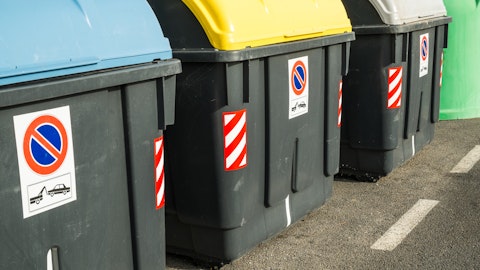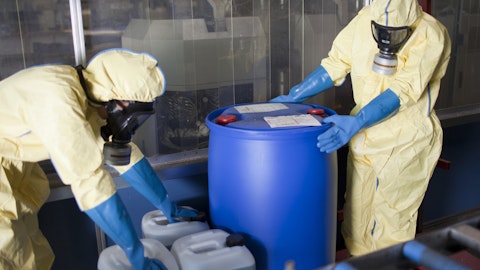Mark Duff: We are still working towards that and working on the parameters of those agreements as well as considering other options, in addition to that. We’re putting the agreements together with several other countries in Central Europe that also include dramatically large backlogs of waste in inventory. The one thing I’ve learned in the last two years that basically every power plant over there has enormous storage building of waste and they would sit now waiting for a treatment facility or for a large long-term storage facility to be developed. And there’s a big market and reducing those volumes back through incineration and significant size reduction that it would save lots of money. In other words, their storage facilities are jammed full.
We’re working with individual firms doing partnering with others to build a backlog, and we intend to ship those waste to Perma-Fix Northwest in the interim and working right now with Westinghouse and other organizations over there to meet that need and thinking outside the box on how to do that. Certainly, the technology we have at our Northwest facility is very applicable and there’s a lot of interest from other companies are in Europe now that are managing those waste for their commercial clients. And I’ve had numerous meetings in the last two months trying to address that need. So it is a very expanding market and we continue to put business together for other countries, as I mentioned before, Croatia, Slovenia, and Norway, and throughout the UK.
So it’s a really growing market. And again, I have a tough time defining what that really means to us in long-term revenue. But I do as several of our agreements will be mature by Q4, and we’ll start seeing shipments increase that in ’25.
Brian Russo: Yeah, great. And then lastly, could you share with us what the services backlog looks like as of December?
Mark Duff: Yes, about — about $14 million.
Operator: [Operator Instructions]. Your next question for today is from Ross Taylor with ARS Investment.
Ross Taylor: Thank you. First, congratulations on surprisingly good quarter. I honestly didn’t think you guys would be able to, given all the back or the headwinds from the government and the like, would be able to put together a quarter like this this quarter. Great job doing that. A couple of things. With this PFAS situation, is your process protected by patents or other intellectual property?
Mark Duff: We do have patents plans for now. Go ahead, Lou. I’m sorry. Go ahead.
Louis Centofanti: Yeah, I’m just going to say we have patents pending, as Mark said earlier, and we expect to be filing quite a few more covering the different applications as we further develop the data for the patents. So we think they are. We’re in the process there. They’re pending at the moment. And they cover the US and Europe. The applications are all set to date in stone for both the US and Europe. And then we’re looking at what to do in Asia.
Ross Taylor: Okay. And when you pursue these opportunities in that area, are you seeing this as Perma-Fix is going to people or I mean, example, like are you going to the DOD, which has obviously a huge problem in this area and trying to basically get a contract with them? Or are you JV-ing in this area? How do you see going to market with it from Perma-Fix–specific standpoint ?
Louis Centofanti: As Mark said initially, the focus is on liquids, whether they be out-of-date products or coming out of fire foam systems today or being generated by some of the separation processes that are presently being used on drinking water and other wastewater. As we expand, we’re somewhat open. There’s been [indiscernible] that the facilities give us a tremendous advantage. We already see liquids — PFAS liquids coming through our facilities. So it’s a natural that we now have a destruction process to destroy them and then —
Ross Taylor: Okay. And so as you said, that’s where you’re sitting with that. And I’m just trying to get an idea what the economics at this point end up being shared economics? Or is this something that you actually believe that early stages you have been able to go out? Your first few wins will be Perma-Fix unique wind, where you’ll be catching the whole other or will someone else be the prime in this. Has the government and other major players actually already started to pursue the type to cures? So are you looking to –?
Louis Centofanti: So we’re hoping to have demonstrations for — we’re already in the process of discussing with DOE a demonstration project for some of their waste. So the same with DOD. So that’s all going on right now. And but again, mostly on the liquids side. The next phase will be focusing on the on-site opportunities that exist out there, and we’re already starting to explore that with —
Mark Duff: We have some agreements in place. They are not formal JV agreements, but we’re working with several companies as partnering that have access or support clients with large inventories. I mean the process we’re going through right now is we’re receiving samples from different clients to run through our pilot and bench scale tests to show them how well it works. The first step is receiving samples from different people, different — that have large backlogs of inventory and partnering with firms that we work with regularly that have clients with have big backlogs. So that’s kind of where how we’re hitting the ground running fast is building that base of inventory that we can — that will get us going.
Ross Taylor: Does this process require you to have significant capital expenditures? Is it the type of situation where you would need to build something at each facility? Or is it the type of approach that allows you to effectively almost create a mobile or somewhat-mobile capability that you can move from location to location? Or would you be putting it on your own locations and having the materials come to you?
Mark Duff: Lou? Go ahead, Lou.
Louis Centofanti: Yeah. Initially, it’s the latter. It’s easy to put a facility and it’s not expensive. You’re basically talking about tanks, reactor tanks, and the pressurized tanks. So step one is do it ourselves at our facilities, gain knowledge on the process, and at the same time, looking at how it can be applied to other applications





